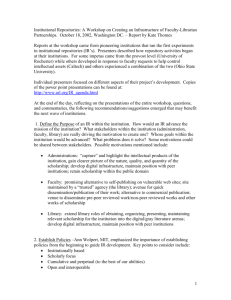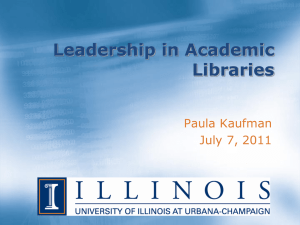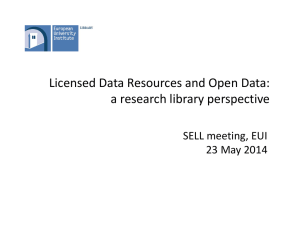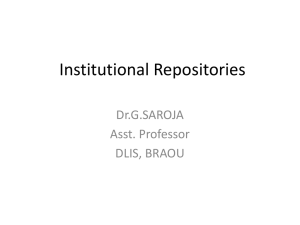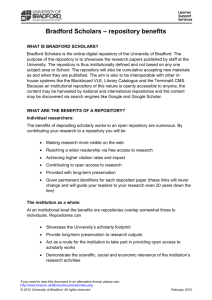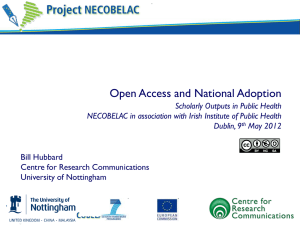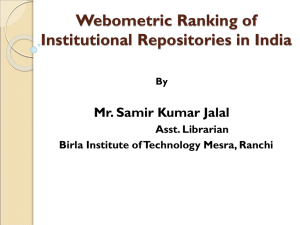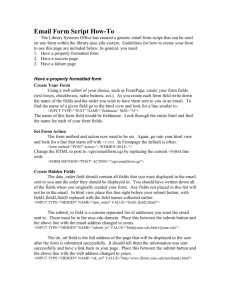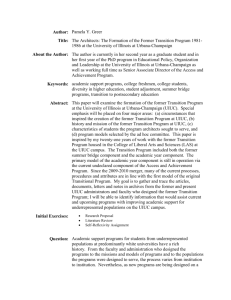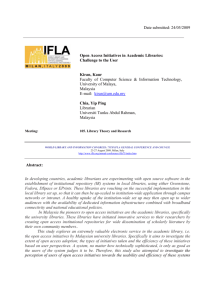Scholarly Communication – Discussion with the Divisions
advertisement
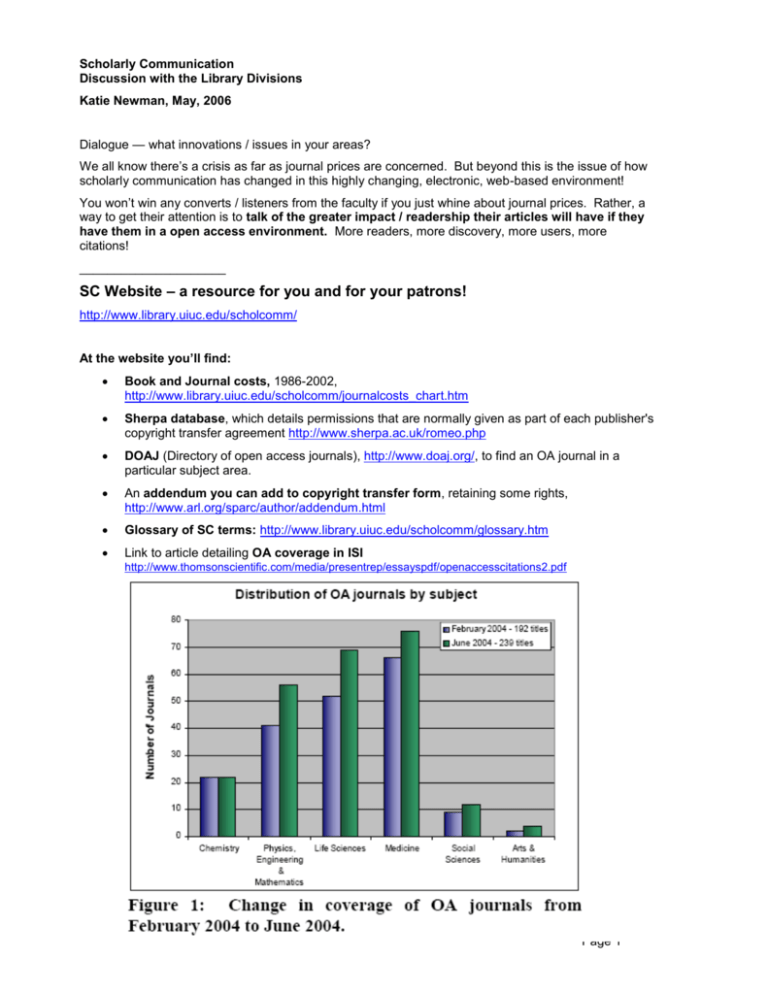
Scholarly Communication
Discussion with the Library Divisions
Katie Newman, May, 2006
Dialogue — what innovations / issues in your areas?
We all know there’s a crisis as far as journal prices are concerned. But beyond this is the issue of how
scholarly communication has changed in this highly changing, electronic, web-based environment!
You won’t win any converts / listeners from the faculty if you just whine about journal prices. Rather, a
way to get their attention is to talk of the greater impact / readership their articles will have if they
have them in a open access environment. More readers, more discovery, more users, more
citations!
_____________________
SC Website – a resource for you and for your patrons!
http://www.library.uiuc.edu/scholcomm/
At the website you’ll find:
Book and Journal costs, 1986-2002,
http://www.library.uiuc.edu/scholcomm/journalcosts_chart.htm
Sherpa database, which details permissions that are normally given as part of each publisher's
copyright transfer agreement http://www.sherpa.ac.uk/romeo.php
DOAJ (Directory of open access journals), http://www.doaj.org/, to find an OA journal in a
particular subject area.
An addendum you can add to copyright transfer form, retaining some rights,
http://www.arl.org/sparc/author/addendum.html
Glossary of SC terms: http://www.library.uiuc.edu/scholcomm/glossary.htm
Link to article detailing OA coverage in ISI
http://www.thomsonscientific.com/media/presentrep/essayspdf/openaccesscitations2.pdf
Page 1
Antelman, K (2003). “Do Open Access Articles have a Greater Research Impact?” College
and Research Libraries, September 2004. Available at:
http://www.lib.ncsu.edu/staff/kantelman/do_open_access_CRL.pdf
Note: for MANY other studies on the effect of OA, see the constantly updated bibliography
started by Hitchcock, “The effect of open access and downloads ('hits') on citation impact:
a bibliography of studies”, http://opcit.eprints.org/oacitation-biblio.html
Peter Suber’s “What you can do to promote Open Access,
http://www.earlham.edu/~peters/fos/do.htm#faculty
Learn about new publishing models, and options to make an article open access –
http://www.library.uiuc.edu/scholcomm/pubmodels.htm
http://www.library.uiuc.edu/scholcomm/openaccess.htm
Page 2
o
Publish in OA journal
o
Publish OA article in non-OA journal
o
Place pre or (better) post-print in IDEALS or other repository
Learn what UIUC is doing http://www.library.uiuc.edu/scholcomm/uiucresponse.htm
o
IDEALS http://ideals.uiuc.edu/ Illinois Digital Environment for Access to Learning and
Scholarship
o
Membership in SPARC http://www.arl.org/sparc/
o
SC News (blog)
http://www.library.uiuc.edu/blog/scholcomm/
Note: keep up to date on issues involving Open Access by subscribing to or visiting
Peter Suber’s Open Access News, http://www.earlham.edu/~peters/fos/fosblog.html
o
2003 UIUC Senate resolution on scholarly communication:
The Committee believes that full access to the published literature is critical for
scholarly activities and must be maintained. The Committee would like the
Senate to approve the following recommendations:
1. that the Library and the faculty work to reduce costs of journals by applying
pressure communicating concerns to publishers,
2. that the Senate engage faculty in debate on this issue in order to encourage
the faculty to apply such pressure facilitate such communication,
3. that the University encourage alternative publishing models, especially
electronic publishing,
4. that the Senate consider the implications of electronic communication to the
promotion and tenure process,
5. that the Senate endorse the Tempe Principles.
SC: Let our researchers know they have options; don’t have to sign away their copyrights, or lose all
control over their work.
Take a look at some other repositories, to see what IDEALS can become!
Oregon’s Scholars Bank: https://scholarsbank.uoregon.edu/dspace/index.jsp (2291 OA
records)
MIT’s DSpace: https://dspace.mit.edu/index.jsp (19652 records)
California’s e-scholarship repository: http://repositories.cdlib.org/escholarship/ (11469 OA
records)
Cornell’s Open Access Repository: Open Access Repository (?? Records)
U Mich Deep Blue: http://deepblue.lib.umich.edu/index.jsp (23903 OA records)
Search multiple repositories
OAISter: http://oaister.umdl.umich.edu/ (7,328,353 records from 634 institutions). Search
across hundreds of institutional repositories.
Search for an appropriate respository:
ROAR: (Registry of Open Access Repositories): http://archives.eprints.org/ (673 archives)
Useful to gauge the number of entries in repositories, and to discover them.
OpenDOAR: (Open Directory of Open Access Repositories): http://www.opendoar.org/ Use
this to find a repository that includes a given subject or is located in a particular country
(number of repositories in the subject shown in parentheses; 2120 total):
Agriculture and Food Sciences (66)
Languages and Literatures (144)
Arts and Architecture (122)
Law and Political Science (161)
Biology and Life Sciences (154)
Mathematics and Statistics (157)
Business and Economics (168)
Philosophy and Religion (116)
Chemistry (120)
Physics and Astronomy (133)
Earth and Environmental Sciences (147)
Science General (87)
Health Sciences (145)
Social Sciences (251)
History and Archaeology (126)
Technology and Engineering (235)
Page 3
Subject Repositories… (note: some publishers only allow deposits into institutional repositories,
not into for profit subject-based archives)
RePEc (Research Papers in Economics): http://www.repec.org/ 178,000 working papers;
192,000 journal articles; and more
E-Lis: Research in Computing and Library and Information Science, http://eprints.rclis.org/
As of 5/06: 3700 entries
DLIST: Digital Library of Information Science and Technology: http://dlist.sir.arizona.edu/
Browse by author, year, subject, and type of material. As of 5/06: nearly 600 entries.
PhilSci Archive. An Electronic archive for preprints in the philosophy of science. http://philsciarchive.pitt.edu/ As of 5/06: nearly 1000 entries.
History and Theory of Psychology. A free service to the community of scholarly historians
and theoreticians of psychology with the goal of promoting the rapid dissemination of new work
in the field. http://htpprints.yorku.ca/ As of 5/06, 107 entries.
Digital Library Network for Engineering and Technology, http://www.dlnet.vt.edu/ Not
primarily a journal article archive, rather it is a repository of "Learning Objects" as well as a
platform for information discovery, interaction, content-building and distribution that will support
pedagogy and learning in Engineering and Technology Covers all areas of engineering:
Aerospace/Aeronautical | Bioengineering | Chemical |Civil | Electrical | Environmental |
Industrial and Systems |Information and Communication Technologies | Materials Science and
Engineering | Mechanical | Mining | Computational Methods | Engineering Education |
Professional Development
Teaching and Learning Research Programme,. http://www.tlrp.org/dspace/index.jsp As of
5/06, nearly 500 submissions.
arXiv.org, e-print archive for physics, mathematics, and related fields such as qualitative
biology, http://arxiv.org/ As of 5/17/06, there were 368,128 submissions!
PubMed Central, Archive of life sciences journal literature at the U.S. National Institutes of
Health (NIH), developed and managed by NIH's National Center for Biotechnology Information,
http://www.pubmedcentral.nih.gov/ As of 5/06 after one year of operation there were nearly
2500 author-submitted manuscripts as well as publisher-submitted archives from about 250
journals.
Page 4
